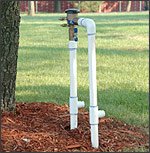|
|
|
 |
winterize your irrigation system in Temperate (Mild) Climates
Winterization is an important part of maintaining a properly running lawn sprinkler system. Where you live plays a big part in which steps you will need to follow. If you live in a region that is temperate - i.e., it either never freezes or only freezes for an hour or two at a time when it does - there are far fewer steps involved when it is time to winterize your irrigation system.
Winterization For More Temperate Climates
The best news about how to winterize your irrigation system in a temperate climate is that the water does not need to be drained from underground pipes. It simply doesn't get cold enough to freeze that deep down in such climates. That means that you can avoid performing a sprinkler system blow out, having to use drain valves or using a shop vac to suction the water out.
As easy as it may be to winterize a lawn sprinkler system in a temperate climate, there are still steps that must be followed. The water supply must still be shut off (as outlined in section one) and you will also need to shut down the timer or controller as well. As mentioned before, the timer may be set to "rain mode," especially if it is a solid state, digital display controller. Doing this can save you a great deal of time and means that you won't have to reprogram the entire thing when spring rolls back around.
Gear-driven rotor sprinklers that are above ground must be drained, or the water can freeze, expand and damage them. If the water doesn't drain out on its own, a drain valve will need to be installed on the sprinkler supply line. Otherwise, you can remove the rotors and shake them out thoroughly; in that case, you should then store them for safekeeping until spring.
Above-ground piping will need to be insulated properly to ensure that it survives the colder time of year. Self-sticking foam insulating tape works the best for this kind of application. Similarly, foam insulating tubes work very well for this purpose.
A Note About Backflow Preventers
 Whether you live in a temperate or a cold climate, you can save yourself a lot of hassle - and make winterization much easier - by insulating your irrigation system's backflow preventer. In cold climates, occasional late and early season freezes occur and can damage your equipment. Using a small amount of self-sticking foam insulating tape - without blocking the drain outlets or the air vents - should be sufficient. Otherwise, try using some R-11 fiberglass insulation. Wrap it around the backflow preventer, then use duct tape to secure a plastic bag around the whole thing. Don't secure it too tightly - just tight enough to keep it from blowing off. Whether you live in a temperate or a cold climate, you can save yourself a lot of hassle - and make winterization much easier - by insulating your irrigation system's backflow preventer. In cold climates, occasional late and early season freezes occur and can damage your equipment. Using a small amount of self-sticking foam insulating tape - without blocking the drain outlets or the air vents - should be sufficient. Otherwise, try using some R-11 fiberglass insulation. Wrap it around the backflow preventer, then use duct tape to secure a plastic bag around the whole thing. Don't secure it too tightly - just tight enough to keep it from blowing off.
Practice Makes Perfect
As outlined above, it is easy to see that winterizing your irrigation system doesn't have to be an impossible task. Doing it yourself can save you a great deal of money, and with every passing season you will become more skilled at it. Having the right equipment and parts can also help tremendously; you can find the best controllers/timers, for example, by visiting www.SprinklerWarehouse.com. Remember, also, that once you've insulated all of your pipes and backflow preventers properly, you will be set for some time and won't need to repeat the process every single year.
|
|
|
Copyright © 2010 IrrigationRepair.com - All Rights Reserved |
|